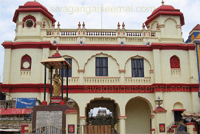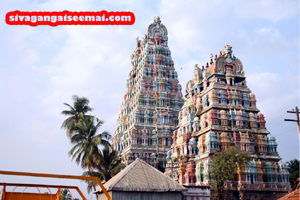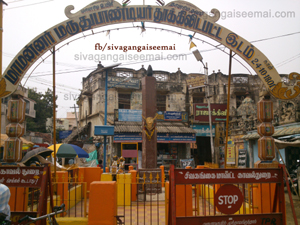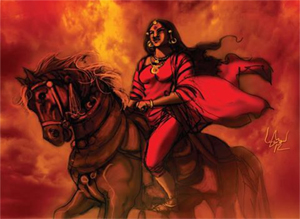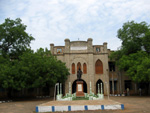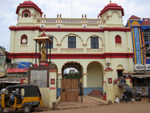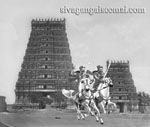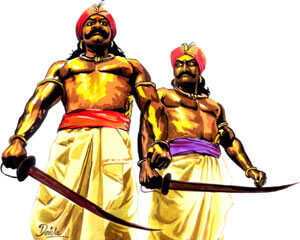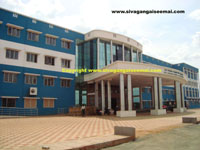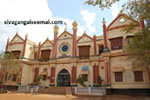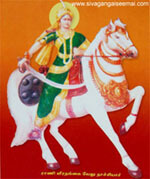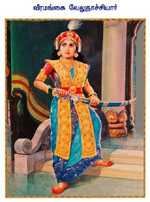Maruthu Pandiyar History
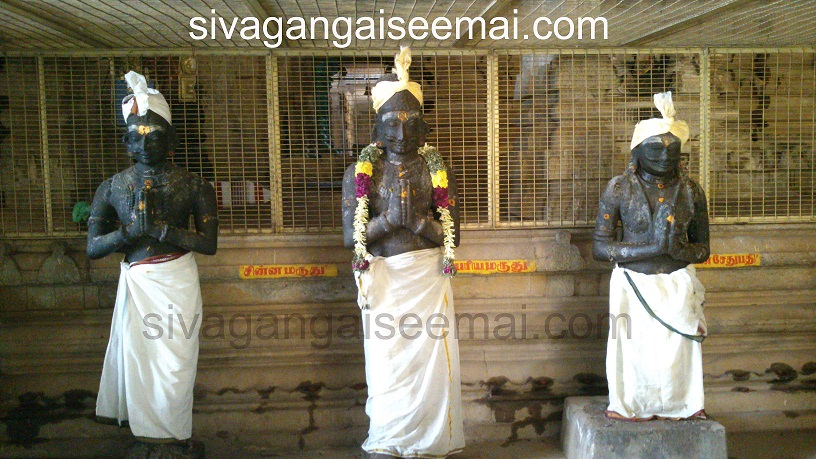
Welcome to read Maruthu Pandiyar History and Maruthu Pandiyar Images and Photos for viewers satisfaction and hope this article fulfill your expectation. The “Murdoos” the rulers of Sivagangai at that time, were two brothers, Vellai Marudu, commonly called Periya Marudu, and Chinna Marudu. They belonged neither to the family of the ancient poligars nor to their division of the caste, but were retainers of the family. Parivaras is the Tamil term for such-belonging to a lower division of the caste. The title peculiar to this class is Servaikara, and they are bound to do service to their poligar masters.. Hence in all English letters and narratives pertaining to that time they are called” Sherogars ""that is, servaikaras, never devas or poligars." There is one version regarding the origin of the Maruthus. The account says that in Ramanathapuram there was a small village by name Alagapuri Mukkulam. The family of Mokkap Pazhaniappan Servai lived there. Mokkap Pazhaniappan Servai served as a commander in the Army. His wife Ponnathal gave birth to a male child in 1748. This child was named Vellai Maruthu. After five years Chinna Maruthu was born.
Real History of Maruthu Brothers
Marudu or Murdoo as it was written by the English, was their family title, not a personal name. Marudu is the name of a tree, the Terminalia alata At the temple of Nainarkovil, in the Ramnad Zamindari, Siva is supposed to have appeared in the shape of a lingam at the foot of a Marudu tree. Hence, as worshipped in that place, he is called Marudappa or Marudesvara. This being the family divinity of the Siruvayal people, each of them, in honour of their divinity, took the title of Marudu. Servaikaran was the caste title, Marudu the family name both the chiefs were called Marudu, with this distinction only, that one was Periya, the elder, and the other Chinna, the younger. Periya Marudu was the nominal ruler of the country. It is he that is meant when the Sherogar or the Marudu is mentioned, but the real ruler was Chinna Marudu. The elder brother devoted himself wholly to field sports and left the administration of affairs in his younger brother’s hands.
Of the two brothers.......... the elder brother was called Wella or Velli Murdoo, but he had nothing to do with the management of the country. He was a great sportsman, and gave up his whole time to hunting and shooting. Being a man of uncommon stature and strength his chief delight was to encounter the monsters of the woods; and it was even said, that he could bend a common Arcot rupee with his fingers. Unencumbered with the cares or trappings of government, he led a sort of wandering life.
The Cheena (Chinna) Murdoo was ostensible sovereign of an extensive and fertile country, and his general residence was at Sherewele (Siruvayal). Though of a dark complexion, he was a portly, handsome, and affable man, of the kindest manners, and most easy access and though ruling over a people to whom his very nod was a law he lived in an open palace, without a single guard, indeed when I visited him in February 1795, every man who chose to come in, had free ingress and agress while, every voice called down the blessing of the Almighty upon the father of his people.
As the father of the Maruthus was an Army Commander, they received military training from him. They started their career as menial servants in the palace of Raja Muthuvaduga Thevar of Sivagangai. By dint of their ability they rose high. They acted as the Minister and Dalavoy of the Raja. After the death of Muthuvaduga Thevar they assisted Velunachi, the widow of Muthuvaduga Thevar.
Thandavaraya Pillai - A Brainee
After the death of the Pradhani, (Thandavaraya Pillai) the Marudhu brothers who were with the Queen (Velu Nachiyar) became prominent. The Marudhu brothers took a lead in the affairs of the occupied territory. They had been looking forward to the opportune moment. The opportunity was thrown in the Second Mysore War in 1780. When Hyder Ali fell upon Arcot in 1780, the Marudhus having obtained a small force from Syed Sahib, the general at Dindigul desolated the Nawab’s territories at Madura. Upon their advance to Sivaganga, the inhabitants joined them and the rebellion spread. The ill disciplined forces of the Nawab stationed in walled towns offered no resistance. The Rani accompanied by the Marudhu brothers entered Sivaganga, and Vellachi, the daughter of Vaduganatha Thevar was proclaimed Queen of Sivaganga and the Marudhus assumed the charge as ministers. The Nawab could not send additional troops to Sivaganga due to preoccupation caused by the invasion of Hyder Ali.
By this time Sivaganga had come completely under the control of the two Agambadias, the Marudhu brothers. Even though the widow of Muthu Vaduganatha Thevar, Velu Nachiar and the Princess Vellachi were there, the de facto rulers were the Marudhu brothers. The usurpation was very much resented by the young ruler of Ramnad, whose off shoot Sivaganga was Muthu Vaduganatha was a relative to the Sethupathi and they belonged to the same sub- caste of Maravas. And as a Marava, Muthuramalinga Thevar naturally did not like the state of Sivaganga, pass into the hands of the Agambadias. This may look ridiculous but the Marava as a class were like this. They were very much concerned about these petty things. Moreover, while Muthuramalinga was in confinement at Tiruchirappalli, the Marudhu brothers looted the Ramnad villages in 1779. They continued that even after Muthuramalinga was reinstated.
The Setupathi now promptly took action and drove them away Even though the Sethupathi succeeded in sending the Marudhus’ troops away he knew that he was not strong enough to remove them from power. Therefore he appealed to the Nawab, who was not very much pleased with the Marudhu brothers, for unification of the two administrations, for an annual payment of 3 1/2 lakhs of rupees. As a next step he proposed to marry Vellachi, the dejure princess, but she foiled the Sethupathi’s plans by marrying Vodaya Thevar, (Sakkanthi Vengai Periya Oodaya Thevar) a nephew of her father The Sethupathi continued his attempts but made no progress. On the 4 th August 1784, the army entered Sivaganga. Fullorton directed the Marudhus to clear the arrears of tributes but the latter withdrew to the woods of Kalayarkoil and assembled about 10,000 armed men. However, a settlement was effected and the Marudhus paid 40,000 rupees as part of the arrears. Determined to suppress the Marudus, the Nawab in 1786 sought military assistance from Fort St. George on the alleged ground that the Marudus refused the payment of the tribute of two lakhs of rupees, that they neglected the administration of their territory and that they committed depredations upon Ramanathapuram. But Governor, Sir Archibald Campbell” rightly cautioned the Nawab that it was dangerous measure to collect revenue by the force of arms and asserted that such a policy not only alienated the subject but caused a heavy military expenditure.
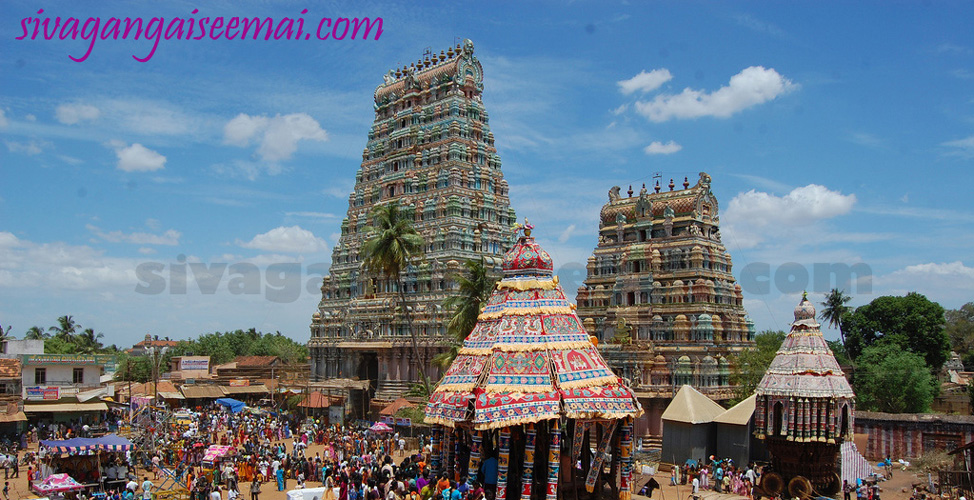
The Nawab and Maruthu Brothers
The situation appeared favourable to the Nawab when a serious rivalry between the Queen and the Marudus for the control of administration disturbed the tranquillity of the territory and weakened its power of resistance. He entered into an agreement with the Rani and promised his assistance in her conflict with the Marudus. This precipitated a clash, In consequence of which the Rani was forced to seek shelter in the fort of Sivaganga. Mohammad Ali promptly despatched a body of troops for the rescue of the Queen. But Marudus with 12,000 armed men surrounded Sivaganga and plundered the Nawab’s territories in retaliation. Unable to suppress the Marudus, Mohammad Ali on the 10 th of March 1789 again appealed to the Madras Council for aid. John Holland, the successor of Sir Archibald Campbell in the Presidency, furnished an army for operation in Sivaganga.
On the 29th April, 1789 the British forces led by Colonel James Stuart arrived at Tirupatore in Sivaganga. where 3000 troops sent by the Tondaiman joined them on the 1 st May . The combined forces reached Sivaganga on the 8th. Reinforced by the Nawab’s detachment, Stuart attacked Kollangudi on the 13 th. A considerable village surrounded by a mud walls and a thick jungle, it was defended by a large body of Marudhus’ troops armed with fire locks. Despite the obstinate resistance of the Marudus, the English forces scored a victory on the 14 th. After this reverse, the Marudus retired to their strongholds in the jungles of Kalayarkoil.
On the arrival of reinforecements from Madura, Thanjavur and Tiruchirappalli , Stuart launched an offensive against the Mardhus’ strongholds which had been constructed in the thick woods. The pioneers laid a road to Ramamandalam situtated three miles from Kollangudi. Stuart won the allegiance of Du Pre, a French General whom the Marudhus employed to train their troops and occupied their stronghold. The thorough knowledge of the terrain possessed by Du Pre, considerably helped further military operations against the Marudhus. The forces advanced to Kalayarkoil, and captured it after a short cannonade. The Marudhus took their stand at Piranmalai, but on the approach of the enemy, fled to the territories of Tippu Sultan.
The Nawab sought to consolidate his gains. He repaired and garrisoned Tirupatore, the key to Sivaganga, with his own troops, destroyed the barriers erected by the rebels, cleared the roads which had been blocked and established military posts. The country returned to order apparently; in consequence of which the forces of Stuart evacuated the territory. The myth of Nawab’s triumph exploded in November 1789, when the Marudus with a large body of their followers returned to Sivaganga and swept off the Wallajah posts. They routed the Nawab’s detachment stationed at Tirupatore and carried the fort. The inhabitants revolting to their chiefs, expelled the troops of the Nawab from their territory. For fear that the Marudus would seek the alliance of Tipu Sultan, the Madras Government now advised Mohammad Ali to settle terms with the rebels. Accordingly, the Nawab granted peace to the Marudus but fixed the peishcush at an enhanced rate of three lakhs of rupees. The Marudus continued as ministers. Vengum Peria Wodaya Tevar, who married Queen Vellachi, assumed the Rajahship; In 1791 the new Rajah represented to the Company, which administered the country by virtue of “assumption” for a reduction of tribute. Considering this demand just, the Madras Council fixed the peishcush at the original sum of 1,75,000 rupees. Neverthless, the Nawab’s endeavour to obtain possession of the territory failed.
The outbreak of the Third Mysore War in 1790 led to the assumption of the revenue administration of the Carnatic. After signing the Treaty of 1787 the Nawab made no attempt to improve the administration. His efforts to put down the defiant poligars invited more financial embarrassment. The Company now doubted whether it could rely upon the Nawab for any material support. In consequence it assumed the administration of revenue of the Carnatic in 1790 in spite of the protests of the Nawab. The Company wanted to create an impression on the people that it would provide a benevolent administration during its period of assumption of revenue administration. It entertained all the revenue servants of the Nawab in its service. The tributes of smaller powers were reduced. These were done to earn the good will of people and the small powers. For Sivagangai the reduced amount was Rs.1,75,000. However the administration was restored to the Nawab in 1792 when the Third Mysore War ended. As condition for restoring the Nawab, he was made to accept a new treaty.
The Carnatic treaty of 1792 was very advantageous to the Company. It gave the English the military and financial control over the Nawab. The Company could assume the revenue but the sovereign was to get one-fifth. The Nawab lost his control over his foreign policy. In addition he assigned the Company the tribute payable by the poligars. Thus practically the poligars came under the Company. The treaty stipulated that the Company would have the right to collect the customary tribute from the poligars. At the same time it also laid down that the poligars were obliged to pay the customary respects and village watch fee to the Nawab. The poligars were to serve two masters. In consequence the poligars served none. The Marudhus of Sivagangai too withheld the payment of tribute to the East India Company. They were not ready to submit themselves under the Company rule.
In an attempt to remove the anomaly created by the Treaty of 1792 and to introduce for its object an entire control of the military powers, the Madras Council made repeated appeals to Muhammad Ali for his consent for a modification. But the Nawab remained adamant to preserve his sovereign rights and paid no heed to the request-30. After the death of Muhammad Ali and on the accession of Umdut-ul-umara on 13th October 1795, the Madras Council found an opportunity to assert itself but rather unconstitutionally. It directed the poligars to obey no instructions of the Nawab unless they proceeded through the Government of Fort St George.
The refusal of Vellachi, the princess of Sivaganga to marry Muthuramalinga added insult to injury. Therefore he fell out with Sivaganga and the Marudus. The Sethupathi closed the road leading from Tirunelveli to Tondi in consequence of which Sivaganga lost customs collected at Parthibanur. In retaliation the Minister of Sivaganga Chinna Marudhu diverted a stream flowing from his territory into Ramnad. Now both the States were armed against each other and entered into hostilities marked by mutual incursions, free-booting and killing of inhabitants.
The conflict spread when several Palayagars openly or clandestinely aided the one or the other. The Madras Council, restricted by the Nawab’s sovereignty over the Marawas could not take any action to nip the trouble in its bud. In consequence; the war continued culminating in battles at Anundur Vasianoor and Paramagudi. But neither side won any decisive victory. The forces of Ramnad set fire to 150 villages in Sivaganga while the Marudus swept off the inhabitants of Paramagudi. Concerned at the magnitude of atrocities, the Madras Council and the Nawab intervened ultimately. Landon, the Company’s Collector of Palayagar - Peishcush directed the Sethupati and the Sherogar to stop the war in an attempt to remove the source of conflict, he suggested to the Setupati to re-open the road and to the Sherogar to let the water to the stream. Chinna Marudu complied with the instructions whereas the Sethupati who had by this time developed a desire for self - assertion ignored the instructions, Thereupon, the Nawab warned the Sethupati that his conduct would involve him in lasting ruin in consequence of which the troops of Ramnad too withdrew from the war.
George Powney, the successor to Landon directed the Sethupati to attend on him and offer an explanation of his conduct, but the latter refused this enraged the Company’s authorities. But they did not immediately march on the Sethupati but waited for the opportune moment. More causes for ill-feeling came. In 1794, when a famine visited the southern provinces, the Madras Council directed the Sethupati to permit the free import of grains to his territory, but he continued the collection of duties. In short the Sethupati ignored the sovereignty of both the Nawab and the British. He was tending to assume independent status.
During the Third Mysore War, the Company assumed the revenue administration of the territories of the Nawab Mohammad Ali and Amir Singh of Tanjavur in 1790. Even though the Mysore incursions did not directly affect the southern countries, it offered an opportunity to the English to invoke the emergency clause in the Treaty of 1787. Besides, the revenue of the Company, though supplemented by the regular payment of the four- fifths of the revenues of the Karnatic and Tanjavur, appeared inadequate to support the expenses of the military operations against the formidable enemy. Moreover, of late the Company was becoming desirous of having control over the Nawab’s and the Tanjavur’s territory. They did not let slip opportunity. The Madras Council felt that any dependence on Mohammad Ali would be futile.
During the period of assumption of revenue administration, the Company wanted to create an impression on the subjects that the Company would provide a benevolent administration. This might have been a prelude to a long range scheme of taking over the country gradually. The Company entertained all the revenue servants of the Nawab and the Rajas in its service. The Board of Assumed Revenue in an attempt to win the attachments of the lesser powers reduced the tribute fixed for Ramnad from Rs. 3,00,000 to Rs. 2,20,000 and that of Sivaganga to Rs, 1,75,000. However the administration was restored to the Nawab in 1792 when the Third Mysore War ended. As condition for restoring the Nawab, he was made to accept a new treaty.
Sivaganga Tourist Places
By fb/Sivagangaiseemai Team / August 28, 2014Kalayarkoil Temple Photos
By Muthukumaran / September 1, 2014Quick Links
Maruthu Pandiyar History in Tamil
Read Maruthupandiyar History in Tamil...
Velu Nachiyar History in Tamil
Velu Nachiyar History in Tamil...
Sivagangai Palace
Sivagangai Palace photo gallery to view Read More ......
Sivagangai Car Festival
Sivaganga Photo Gallery
2008 - www.sivagangaiseemai.com
ALL Rights Reserved. Privacy Policy

